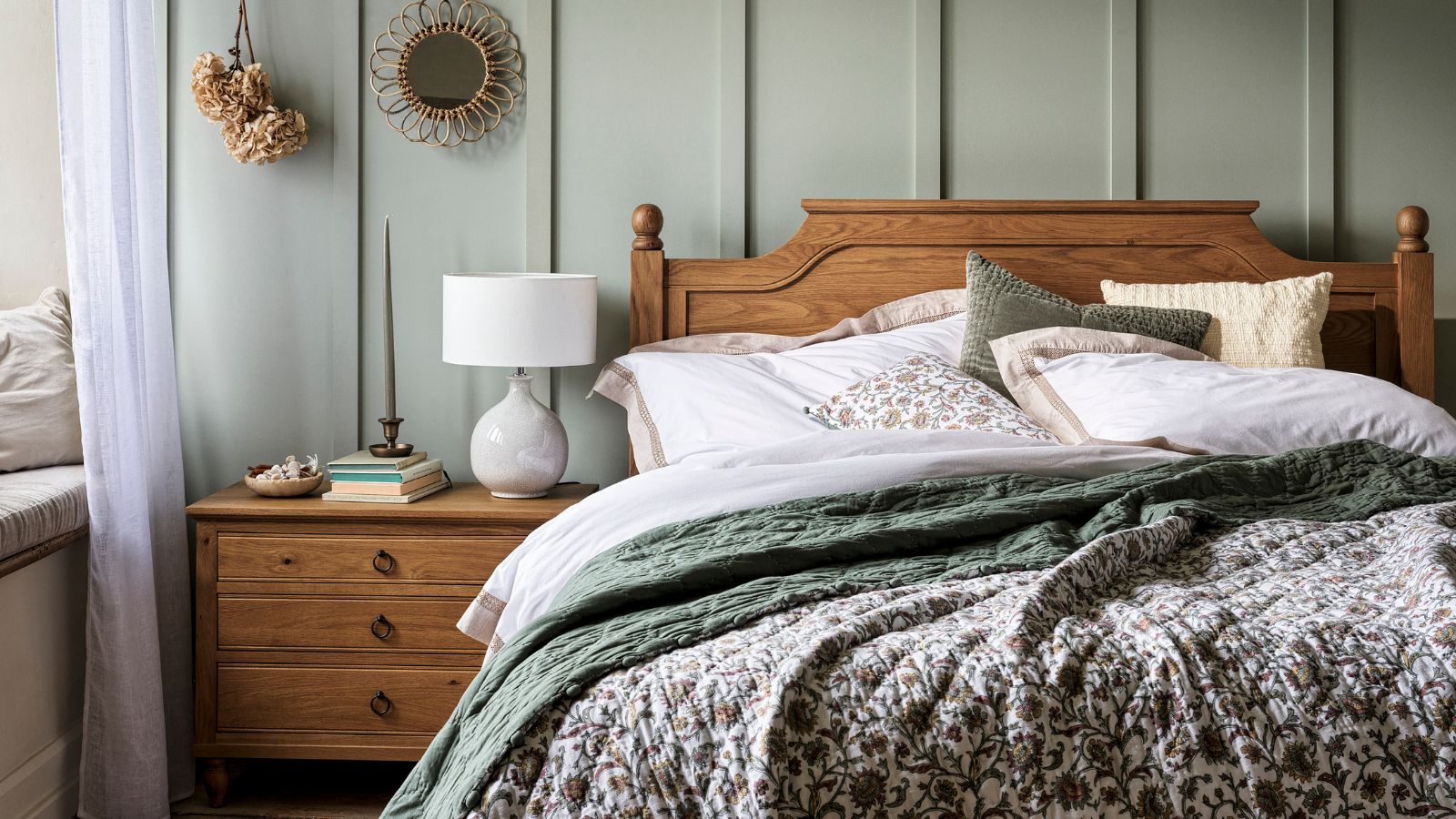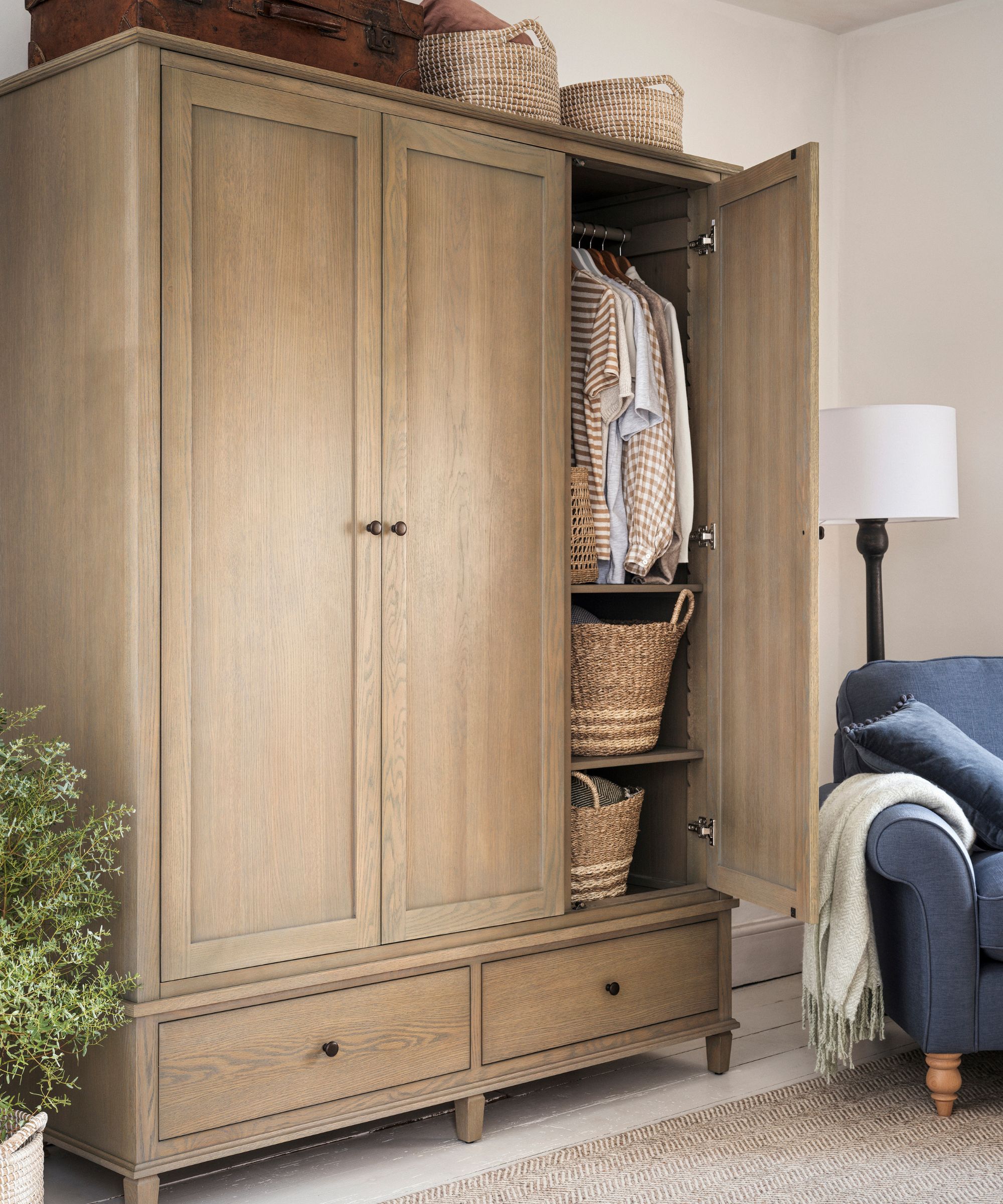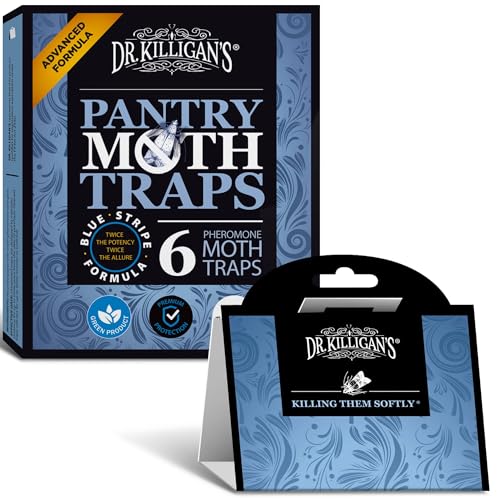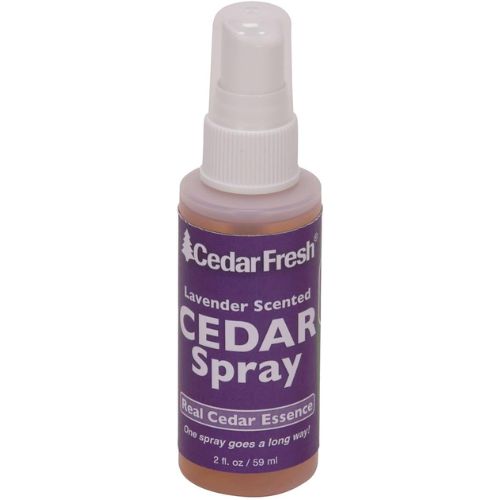How to get rid of moths – 11 entomologist-approved methods from deterrents to storage
Pest experts share their tried and tested solutions


Lara Sargent
The last thing you want when pulling clothes and linens out of storage is to find little snack holes, left behind by hungry moths.
So, how do you get rid of moths and prevent a moth infestation that could potentially ruin the contents of your closet and your home’s soft furnishings?
Here, top entomologists share their favorite ways to banish these common indoor pests from the home for good – from specialist moth deterrents and traps, to organic sprays and storage tips.
11 ways to get rid of moths
1. Store out-of-season clothes properly

Storing clothes properly is crucial when it comes to keeping moths at bay.
When it’s time to swap over your seasonal clothing, don’t just chuck everything in a bin bag and stash it in the attic – acing your long-term clothes storage is a must to prevent moths, says Nicole Carpenter, president of Black Pest Prevention.
She suggests, 'Once clothes are clean and completely dry, put them in airtight bins, vacuum-sealed bags, or containers with secure lids – thin plastic or loose zippers won’t stop moths,' she warns. 'Moths can chew through flimsy materials, so choose something made of thicker plastic or metal.'
For this, Dr. Tracy Ellis, award-winning entomologist at FarmSense, recommends using airtight sweater boxes and bags, such as the Household Essentials Cedarline Zippered Sweater Bag available at Amazon, and the bestselling Sterilite Small Storage Bin available at Walmart. 'The storage containers are effective in making a physical barrier to prevent moth penetration and also allow easy visibility of contents,' she says.
'Some people may want to vacuum-seal garments using clear vacuum-sealed bags,' adds Tracy, recommending these Vacuum Storage Bags available at Amazon.
Design expertise in your inbox – from inspiring decorating ideas and beautiful celebrity homes to practical gardening advice and shopping round-ups.
2. Deep clean your closet

Regularly vacuum and wipe down surfaces in your closet.
Equally as important to getting rid of moths is deep cleaning your clothes closet, paying particular attention to corners, cracks, and shelving.
Daniel Baldwin, board-certified entomologist at Hawx Pest Control, advises, 'Something as simple as a regular cleaning routine around your home can help prevent moths from causing havoc to your belongings.
'Thoroughly vacuuming carpets and flooring [with the best vacuum you can afford] can help to remove any moth eggs and prevent them from hatching, as can regularly dusting and wiping down surfaces.' Using a Microfiber Cleaning Cloth, available at Walmart with a multipurpose spray, such as the Method All-Purpose Cleaner, also available at Walmart, is great for this.
Importantly, says Nicole, always empty your vacuum outside after vacuuming a pest problem to prevent reinfestation of your home.
Daniel adds, 'Seasonally air out carpets, curtains, and regularly rotate stored clothing to disrupt moths from mating and laying their eggs in these areas.'
3. Keep clothes squeaky clean

Keep your clothes clean to prevent moths feeding on them.
Even when you’ve used some closet decluttering tips and streamlined your closet for the new season, you need to keep clothes super clean to prevent a moth infestation. This is because moths feed on protein, which can be found in natural fibers, like cashmere, wool, and silk, but also in hair, dust, and food spills.
Daniel advises, 'Every so often, take your clothing and fabrics such as bedding and curtains to the dry cleaners to eliminate the moisture that can attract moths. Taking fabrics to the dry cleaners can also help to kill existing moths and their larvae hiding within fabrics, so it’s worth paying for a couple of times a year to eliminate a potential infestation.'
You can also do laundry yourself for a quick remedy.
As with killing ticks in a washing machine, Tracy adds, 'Washing your clothing and fabrics on a hot-water cycle can help to eliminate moth infestations. Before washing any of your clothing at high temperatures, check the laundry symbols to see that they're able to withstand hot-water cycles, otherwise, you could risk damaging them permanently.
'Use your usual detergent and choose a cycle that runs at least 140 degrees Fahrenheit (60 degrees centigrade). The hot water will kill any live moths and their larvae that could be living on your fabrics.' We recommend using the bestselling ARM & HAMMER Plus OxiClean Odor Blasters Fresh Burst available at Walmart for this.
If you don’t want to wash your clothes so regularly, experts recommend shaking clothes from your closet every day, or thereabouts. Clothes moths don’t like disturbances, so this will help prevent moths from settling in and laying eggs.
4. Use a natural moth deterrent

Use sustainable and eco-friendly solutions, like lavender and cedarwood, if you're unsure how to get rid of moths.
For a sustainable way to deter moths, you can use bay leaves to deter closet pests, or try an organic or homemade bug spray that’s made using natural essential oils such as lavender, rosemary, or chrysanthemum.
John Stewart from Green Protect, a brand offering sustainable solutions for a pest-free home, explains, 'Organic deterrents are one of the best ways to get rid of moths and act as a fantastic preventative measure. Herbs like rosemary, lavender, and bay leaves repel moths – and the oil from these can also be sprayed on contaminated areas.' You can purchase Majestic Pure Rosemary Essential Oil at Amazon, and Mainstays 100% Pure Essential Oil in Lavender at Walmart, and pop them in a spray bottle, such as the Equate Plastic Spray Bottle, also available at Walmart.
Alternatively, you can also use non-toxic cedar rings, such as the Cedar Blocks for Clothes Storage available at Amazon, says entomologist Daniel. 'Anecdotal evidence suggests that natural repellents such as cedarwood, lavender, and cloves can deter moths,' he explains. 'You can obtain cedarwood hangers that can be hung alongside your garments in your wardrobe, as well as lavender or clove bags that can be placed inside clothing or drawers to prevent moths.
'The natural scents could help to prevent moths from entering wardrobes, closets, and drawers, which will reduce the risk of an infestation.'
5. Set a moth trap

Use sticky or pheromone traps to prevent moths breeding.
To get rid of moths that have already entered your home or storage, consider setting up traps.
John explains, 'Using pheromone lures is a good way of trapping adult, male moths as they perceive the signal as a female and therefore enter the trap with the aim of breeding. Trapping the male will help in suppressing the population as the male may not get the chance to breed.'
Pheromone traps, such as the LONDON MOTH KILLER. 10 Premium Pheromone Moth killers available at Amazon, are generally effective for up to eight to 12 weeks (check individual products), after which the sticky pads should be replaced.
Total Wardrobe Care also offers a clever Moth Decoy product, available at Amazon, to guard against moth damage. The small micro-powder tablet is infused with pheromones from the female moth, which attracts nearby male moths. When the male moth comes into contact with the electrostatic powder, it sticks to the antennae, blocking the receptors and confusing the moth into attracting other males rather than female partners. This breaks the breeding cycle over time, without any moths being killed.
6. Get tough on carpet moths

Regular vacuuming is the best way to banish carpet moths
Regular and thorough vacuuming with your best vacuum cleaner for carpet is the best way to get rid of carpet moths, and will remove any eggs or debris that might be in the carpet, too.
Our top pick is the Shark POWERDETECT Upright Vacuum Cleaner available at Amazon. Pay attention to dark areas of carpet under and behind furniture, and along the skirting boards, and remember to frequently empty the vacuum cleaner.
As Julian Downes, managing director of Fibre Flooring, explains, 'Wool carpets contain keratin, which is attractive to moths, but there are things that you can do to keep them at bay.
'Most wool carpets are sold already moth-proofed, but for an additional natural remedy, you can use bags of dried lavender and cedar balls, which repel moths and other insects,' just like those that you would use in a closet.
Julian continues, 'Sisal is an ideal floor covering for properties prone to moths and also dust mites; it is 100% plant-based and doesn’t contain keratin, the enzyme that attracts moths to live or breed in certain materials.'
7. Remove stains promptly

Moths will be attracted to food and drink spills on carpet.
Entomologist Daniel continues, 'Make sure you clean up any food or drink spills on sofas or carpets as soon as they happen. Moths are drawn to stains, especially those from food, beverages, and pet urine, therefore, you must soak up any moisture to avoid attracting them to the area.'
To remove food and drink stains from carpets, you can clean carpets with baking soda or clean carpets without a machine with an enzyme spray, such as the Rocco & Roxie Stain & Odor Eliminator available at Amazon.
If you would prefer to use a machine to deep clean a carpet, we recommend the BISSELL Little Green Multi-Purpose Portable Carpet and Upholstery Cleaner available at Amazon.
Alternatively, you can also steam clean carpet, which will help to eliminate moth eggs, too.
8. Use vinegar

Vinegar both kills and deters moths.
Cleaning with vinegar is a great way to remove visible larvae before they hatch, recommends Stewart Muir, an associate-certified entomologist at JP McHale Pest Management.
‘White vinegar is a natural cleansing agent that changes the pH levels of surfaces that it touches, and moth eggs and larvae exposed to white vinegar cannot survive in the acidic environment,’ he explains. ‘You could, therefore, use a sponge [such as the Dawn Foam Sponge available at Walmart] or rag to apply vinegar to a surface or apply it with a spray bottle.
'Make sure to take care when using white vinegar in the home, as it can damage certain surfaces, such as metals, stone countertops, hardwood floors, and certain clothing. Always spot-check the cleaning solution first before committing to using the solution on a large visible area.'
You can also make vinegar traps, which are a common solution to a range of pest problems, such as getting rid of gnats. It is also the simplest and easiest solution, trapping moths long after you have set it and walked away. Simply place a small bowl or jar near the affected area and fill it with a mixture of Apple Cider Vinegar, available at Walmart, and a few drops of dish soap, such as the MRS. MEYER'S CLEAN DAY Liquid Dish Soap available at Amazon.
To prevent moths from coming in in the first place, you can also make small vinegar-soaked balls to leave around your home. To do this, Nate Nead, principal pest control expert at Bentonville Pest, suggests soaking cotton balls, like these organic cotton balls from Amazon, or fabric sachets in vinegar, and strategically placing them in areas where you want to deter moths.
Additionally, if you find moths in your closet, you can soak your clothes in vinegar to make sure they are free of larvae. You can either use white vinegar in laundry and wash your clothes as normal, or for bad infestations, soak the garments directly in white vinegar, such as the Great Value Distilled White Vinegar available at Walmart, for a few hours before washing as normal to remove the odor.
9. Find and block entry points

Prevent more moths from entering your home and worsening the infestation.
Daniel says, if you’ve seen moths around your home, it’s worth inspecting the areas you’ve found them for potential entry points, to eliminate the ways these insects are entering your home.
'They can get in through cracks and gaps, and can use your ventilation system as passageways,' warns Daniel. 'Use a torch and examine the walls and ceiling in the attic. Make note of any damage and arrange for repairs.'
For a quick fix for easy problems, use caulk, such as the GE Advanced Silicone Caulk available at Amazon, to seal any cracks and crevices.
10. Be alert to pantry moths

While less common, pantry moths can also pose a significant issue.
Food moths are less common than clothes and carpet moths, but can still pose a problem by eating through food stores, leaving excrement behind, and spoiling food.
If you have seen small tan, brown, or grey winged insects fluttering about in a zig-zag pattern, you might need to get rid of pantry moths. The most common is the Indian meal moth, which is less than half an inch long with a small, bronze-colored head, a yellowish top half of the wing, and reddish brown on the bottom.
Nicole explains, 'Moth larvae are the last things you want to see in your food when grabbing a midnight snack. Pantry moths love to infest dry foods like grains, cereals, and flour.
'If you find moths, inspect food storage areas in the kitchen and garage that contain dry goods such as breakfast cereal, dry peas, rice, crackers, bird and pet food. Inspect each item for freshness and make sure the wrapping shows no rips or leaks. Once you have sanitized and removed any suspected harborage, develop the practice of freezing overnight any newly acquired nuts, seeds, rice, and other dry goods before placing them in the cupboard. This will eliminate the pathway that stored product pests take to get into your home.
'Once packages are opened, use the foodstuffs quickly or store them in a sealed plastic bag, such as the Ziploc Gallon Food Storage Slider Bags available at Amazon, or reusable, tightly sealed lidded containers, such as the number one bestselling OXO Good Grips POP Container, also available at Amazon.
'Luckily, stored product pests are a simple pest to remedy by use of freezing, cleaning, sealed food storage, and discarding any compromised food packages' when decluttering your pantry.
11. Freeze fabrics

Freezing fabrics effectively kills moths without any fuss.
Finally, says Daniel, freezing fabrics which are already affected is an effective and oft-recommended method for those wondering how to get rid of mtohs.
'Temperatures at 0 degrees centigrade (32 degrees Fahrenheit) will kill moth eggs and larvae,' he explains. 'For individual fabrics, place them into a plastic bag [such as the BPA-free Amazon Basics Reclosable Freezer Quart Bags available at Amazon] and into an empty drawer in your freezer, keeping them in there for at least 72 hours.
'This will completely eliminate adult moths and kill any larvae contained within the fabric.'
What to shop
All prices were correct at the time of publication.

These bestselling pantry moth traps feature double-potent pheromones and the stickiest glue to lure and capture moths, for a long-lasting solution that's effective for up to six months

These traps are ideal for use in closets and wardrobes, designed to repel bugs and protect your clothes with a sticky pheromone glue.

This natural cedar and lavender spray restores cedar wood scents, using concentrated essential cedar oil for maximum scent and effect.
FAQs
What causes lots of moths in the house?
Moths can enter your home through open windows or doors, and can also be carried in on clothes and soft furnishings. Always be sure to shake out any clothes that are not packaged, like those from a charity shop or car boot sale, before you bring them into the house. Keep your closet ventilated too, regularly opening the door to increase airflow, as moths are attracted to warm, humid spaces.
If you have noticed a lot of moths in your home, it may be that there is a mess attracting them in and offering them adequate food to set up a breeding ground. A common source is food, whether it has been stored incorrectly or has been spilled and not cleaned up. You may have also carried moth larvae in when moving outdoor furniture inside, where they have hatched and continued to breed.
Meet our experts

Nicole is the president of Black Pest Prevention, a North Carolina-based company serving both North and South Carolina. She began working in the pest control industry in high school and continued gaining hands-on experience throughout her years at N.C. State University. With decades of field knowledge and leadership, Nicole brings a practical, expert-level understanding of real-world pest challenges homeowners face.

Dr. Tracy Ellis is an award-winning entomologist at FarmSense, who has worked for the USDA and other government agencies surrounding insect quarantine enforcement and eradication programs. She also has extensive experience in working with farmers, stakeholders, and communities surrounding pest detection, monitoring, regulation, and suppression tactics. Her research has significantly impacted biopesticide discovery, innovation, and commercialization.

Daniel is an entomologist with over a decade of experience, working at Hawx Pest Control which, since being founded in 2013, has grown as a business across 12 states.
While you may have gotten rid of your moth problem, getting rid of the smell of mothballs can be equally as difficult. Our experts recommend airing out laundry and using vinegar or baking soda as a quick and inexpensive fix.

Ottilie joined Homes & Gardens last year, after finishing a Master's in Magazine Journalism at City, University of London. With previous contributions in Livingetc and Motorsport Magazine, she produces content for the Solved section on the website, focusing on clever tips and tricks to keep your home beautiful, organized, and clean, with particular expertise on all things home fragrance. She also has a Master's degree in English Literature and History of Art from the University of Edinburgh, where she developed a love for inspiring interiors and architecture.
- Lara SargentContributing Editor